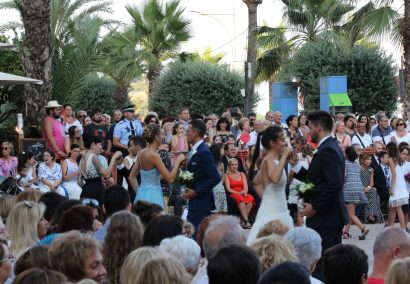Biblical performances and mystery-plays are commonplace across Spain during the Holy Week (La Semana Santa). The tradition dates back centuries: the language of Mass had been Latin while not many people knew how to read, so the reenactments of popular Biblical themes were an effective way for the Church to promote the Christian doctrine among the masses.
The religious holiday La Processó de Verges, taking place in Verges on Maundy Thursday is recognized by the Generalitat of Catalonia as a part of the cultural heritage of the nation. For the most part, it owes its popularity to The Dance of Death (La Dansa de la Mort) which wasn’t mentioned in the gospel yet has become an essential part of the Procession of Verges.
The performance is based on a poem Representació de la sagrada Passió y Mort de Nostre Senyor Jesu-Christ, written in 1773 by Antoni de Sant-Jeroni, a Catalan writer and monk. To start, the following scenes are reenacted on Plaça Mayor:
- Jesus’ triumphal entry into Jerusalem
- The Samaritan Woman
- The Last Supper
- The Sanhedrin
- The Garden of Gethsemane
- Pontius Pilate and the condemning of Jesus
The Holy Cross Procession begins immediately after, and all the action shifts from the central square onto the neighbouring streets. The scenes of the first, second and third falls of Christ are enacted on Carrer de la Placeta, on the square Plaça Onze de Setembre and on Carrer de la Font, respectively. The two-hour long procession terminates at the church of Sant Julià, where the Crucifixion is acted out.
The Dance of Death was conceived in France in the 14th century as a way to interpret the poem of the same name, in which Death invited very different characters to dance: the Pope, a bishop, an emperor, an ordinary peasant etc. The author wanted to demonstrate that we were all equal in the face of death, avoiding which was futile regardless of one’s material wealth or power.
The Catholic Church managed to shift the narrative and use the satirical piece to its advantage. The idea of equality gave way to the fearsome reminder that Death awaited at every corner and one shouldn’t wait to find Christ and immerse oneself in religious piety. (As if all the wars, plagues and famines were not reminder enough.)
From France, the Dance migrated down south, becoming an essential part of Easter celebrations in many towns across Spain until the beginning of the 20th century. Today, it is performed only in Verges and Manresa.
The dance is performed by five “skeletons”: two adults and three children. One of the adult actors is holding a black banner, and the other one has a scythe. Both the banner and the scythe handle contain two mottoes: in Catalan, Lo temps és breu, or Time is short; and, in Latin, Nemini parco, or I spare no one. Two kids are carrying plates filled with ash, while the third has a clock without handles. This artistic puzzle implies that anyone can turn to ash at any moment.
The menacing dancers first appear in front of the audience after the scene at the Sanhedrin. After that, you can see the jumping skeletons twice more: during the Holy Cross Procession and in the final scene of the celebration.
Practical information
The performance is split into three parts, beginning at 5 pm, 10 pm and 00:30 am respectively.
The first part is essentially a repetition of the Roman legionaries’ march along the town streets, which happens every hour. Arriving in Verges this early only makes sense to find convenient parking, as the town doesn’t boast any major sights or tourist attractions. You can kill time before 10 pm while having dinner, but do reserve a table in advance — there aren’t that many restaurants in Verges, and they all get full very quickly on the evening of the Dance of Death. Give Restaurant Mas Pi a go first — it’s spacious, with an incredibly attentive staff. (Phone no.: 972 78 06 12)
The second part, the theatrical performance on Plaça Major, begins at 10 pm. The event is ticketed; you may buy admission at the tourism office of Verges or online on the official website of the event. Do so in advance, as most good seats are sold out two or three days before the performance.
The closing part, the street procession, begins right after the second portion ends. You don’t need a ticket to see it, but some effort is still required to enjoy it without having to fight through the crowds. One solution: occupying a seat on the last row closest to Carrer Major and waiting for the procession to pass you by in comfort. It will do so at approximately 00:45 am.
The Procession of Verges ends at around 3 am.
Because the mystery-play always takes place on Maundy Thursday, and Easter dates are known years in advance, you are all set to start planning a visit early. The closest dates are as follows:
- 2023: April 6
- 2024: March 28
- 2025: April 17
- 2026: April 2
- 2027: March 25
- 2028: April 13
- 2029: March 29
- 2030: April 18
- 2031: April 10
- 2032: March 25
- 2033: April 14












